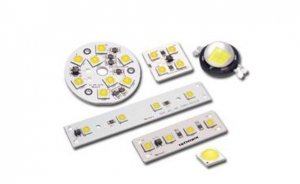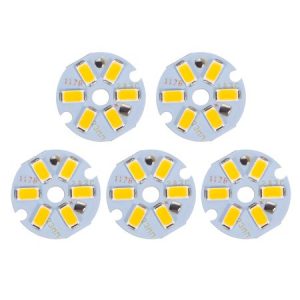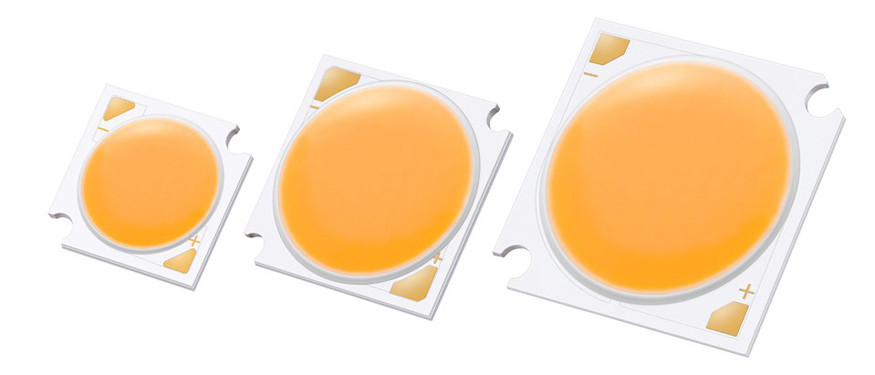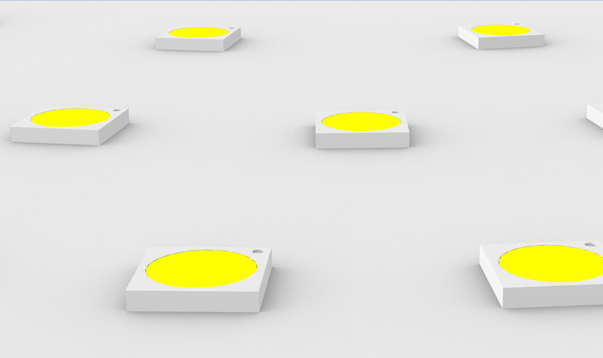Brief Introduction on LED Beads
LED Beads
LED English is (light emitting diode), LED lamp bead is the abbreviation LED for light emitting diode, which is a popular name.
Principle of luminescence
The terminal voltage of the PN junction constitutes a certain potential barrier. When a forward bias voltage is applied, the potential barrier drops, and the majority carriers in the P and N regions diffuse to each other. Since the mobility of electrons is much greater than that of holes, a large number of electrons will diffuse to the P region, which constitutes the injection of minority carriers in the P region. These electrons recombine with the holes in the valence band, and the energy obtained during the recombination is released in the form of light energy. This is the principle of PN junction light emission.
Category of LED Beads
- In-line low-power specifications are: straw hat/steel helmet, round head, concave, oval, square (2*3*4) bullet head, flat head, (3/5/flat head/bread type) piranha, etc.
- SMD patches are generally divided into (3020/3528/5050 these are front light)/1016/1024, etc. These are side light sources.
- High-power LEDs cannot be classified into SMD series. Their power and current usage are different, and their photoelectric parameters are quite different. If a single high-power LED light source does not have a heat sink base (usually a hexagonal aluminum base), its appearance is not much different from ordinary patches. The high-power LED light source is round and the packaging method is basically the same as that of SMD patches. However, it is essentially different from SMD patches in terms of use conditions/environment/effects.

- According to power
There are 0.06W, 0.08W, 0.2W, 0.5W, etc. for low power, and 1W, 3W, etc. for high power.
- By color
Can be divided into red, blue, yellow, green, white, amber, etc.;
- According to the wafer form inside
can be divided into single crystal element, double crystal element, three crystal element, multi crystal element, etc. There are also those with protection diodes and without protection diodes
- Plug-in type according to the diameter
Can be divided into round 3mm, 5mm, 8mm, 10mm, square, etc.; patches are: 3014, 3528, 5050, 5630, etc.;
- According to the color of LED lamp beads
According to the color of the luminous tube, it can be divided into red, orange, green (subdivided into yellow green, standard green and pure green), blue light, etc. In addition, some light-emitting diodes contain chips of two or three colors.
According to the light emitting diode doped or not doped with scattering agent, colored or colorless, the above-mentioned light emitting diodes of various colors can be divided into four types: colored and transparent, colorless and transparent, colored scattering and colorless scattering. Scattering light-emitting diodes and up to serve as indicator lights.
- According to the characteristics of the light-emitting surface of the LED lamp beads
According to the characteristics of the light emitting surface of the luminous tube, it can be divided into round lamps, square lamps, rectangles, surface luminous tubes, lateral tubes, and microtubes for surface mounting. Among them, round lamps are divided into φ2mm, φ4.4mm, φ5mm, φ8mm, φ10mm and φ20mm according to their diameters. In foreign countries, light-emitting diodes with φ3mm are usually recorded as T-1; those with φ5mm are recorded as T-1 (3/4); and those with φ4.4mm are recorded as T-1 (1/4). The angular distribution of circular luminous intensity can be estimated from the half-value angle.
From the angular distribution of luminous intensity, there are three categories:
(1) High directivity. Generally, it is a pointed epoxy package, or a package with a metal reflective cavity,
and no scattering agent is added. The half-value angle is 5°~20° or less, with high directivity, and can be
used as a local illumination light source, or combined with a light detector to form an automatic detection
system.
(2) Standard type. Usually used as indicator light, its half-value angle is 20°~45°.
(3) Scattering type. This is an indicator light with a larger viewing angle, the half-value angle is 45°~90° or
more, and the amount of scattering agent is larger.
Features of LED Beads
- Voltage: LED lamp beads use low-voltage power supply, the power supply voltage is between 2-4V, depending on the product, so it is driven by a safer power supply than high-voltage power supply, especially suitable for public places;
- Current: working current is 0-15mA, brightness becomes brighter with the increase of current
- Efficiency: Energy consumption is reduced by 80% compared with incandescent lamps with the same light efficiency.
- Applicability: small, each unit LED chip is 3-5mm square, so it can be prepared into various shapes of devices, and is suitable for changing environments.

- Response time: The response time of the incandescent lamp is milliseconds, and the response time of LED lights is nanoseconds.
- Environmental pollution: no harmful metal mercury.
- Color: Change the color by changing the current. The light-emitting diode can easily adjust the energy band structure and band gap of the material through chemical modification methods to achieve red, yellow, green, blue, and orange multicolor light. For example, a red LED at low current can change to orange, yellow, and finally green as the current increases.
Parameter Description of LED Beads
- Brightness
The brightness of LED lamp beads is different, and the price is different.
Lamp beads: general brightness is 60-70 lm;
Bulb light: general brightness is 80-90 lm.
1W red light, the brightness is generally 30-40 lm;
1W green light, the brightness is generally 60-80 lm;
1W yellow light, the brightness is generally 30-50 lm;
1W blue light, the brightness is generally 20-30 lm.
Note: 1W brightness is 60-110lm; 3W brightness is up to 240lm; 5W-300W is an integrated chip, which is packaged in series/parallel. It mainly depends on how much current, voltage, how many strings and how many parallels.
LED lens: PMMA, PC, optical glass, silica gel (soft silica gel, hard silica gel) and other materials are generally used for the primary lens. The larger the angle, the higher the light output efficiency. With a small-angle LED lens, the light must be shot farther.
- Wavelength
The wavelength is the same, the color is the same. The price is high.
White light is divided into warm colors (color temperature 2700-4000K), pure white (color temperature 5500-6000K), and cool white (color temperature above 7000K). Europeans prefer normal white, while Americans prefer warm white.
Red light: band 600-680nm, of which 620 and 630 are mainly used for stage lights, and 690 is close to infrared.
Blue light: band 430-480nm, of which 460,465 stage lights are used more.
Green light: Wave band 500-580nm, of which 525,530 stage lights are used more.
- Beam angle
LEDs with different uses have different beam angles. Special lighting angle, higher price.
- Antistatic ability
The LED lamp beads with strong antistatic ability have long life and high price. Generally, only LED lamp beads with an antistatic value greater than 700V can be used for LED lighting.
- Leakage current
LED lamp beads are unidirectional conductive luminous bodies. If there is a reverse current, it is called leakage. LED lamp beads with large leakage current have short life and low price.
Scope of application
LED lamp beads are widely used in many production fields such as lighting, LED large-screen display, traffic lights, decoration, computers, electronic toys and gifts, switches, telephones, advertising, urban brilliance projects, etc.
Prospect of LED Beads
LEDs are called semiconductor light-emitting diodes. They are made of semiconductor materials to directly convert electrical energy into light energy and electrical signals into light-emitting devices. It is characterized by low power consumption, high brightness, bright colors, anti-vibration, and longevity. The advantages of long (normal light emission between 80,000 and 100,000 hours) and cold light source are real “green lighting”. Lighting products using LEDs as light sources will inevitably replace white woven lights and become another revolution in human lighting in the future of the 21st century.
Common Problem of LED Beads
- Problems caused by abnormal power supply:
- Check whether the power supply is working normally, whether the indicator light is on, if not, please check whether the power supply is connected;
- Check whether the power cord of the lamp bead is connected with the positive and negative poles of the power supply, and whether it is reversed. If the above problems exist, please connect them correctly.
- LED lamp beads for voltage requirements:
The nominal 3V LED lamp beads, in fact, different colors have different requirements for current, yellow requires the smallest current, followed by red, green, white, and blue. Excessive current will scorch the wick. Use 2.4V rechargeable battery, it is easy to burn, because even if the voltage is not large, but the current is too large, it will still burn.
- No power detection LED:
If it is not powered on, if it is convenient to choose when purchasing, it is recommended to prepare a 3V button battery, which can be used to easily check what the LED emits when selecting.
- Reasons for burning high-power LED lamp beads:
a. The upper and lower two filaments are called gold wires in our industry. Pure gold is used for conducting electricity. Two positive poles and two negative poles. A really good product will have a fifth wire, which is welded to the Zener tube. Protective.
b. When the filament becomes shorter, it tells you clearly that your lamp has been burned by a large current, which is equivalent to a circuit breaker.
c. The high-power 1W drive current is about 350ma, and the working voltage is between 3.2-3.6V. Please be careful when using it. Excessive current will definitely burn the lamp.
d. Generally, the aluminum substrates of the three 1W lamps are driven by about 12V, and few of them are directly used on 220V. - Reasons for the yellowing of LED lamp beads:
The yellowing of the LED outer encapsulant is mostly caused by the mismatch between the epoxy resin and
the curing agent, but it cannot be ruled out that the baking time of the outer encapsulant is too long. Solution: Purchase a complete set of external sealant and curing agent, pay attention to production control, strictly follow
the operation instructions, and avoid reasons such as excessive or insufficient baking time. This situation is well controlled.
- Reasons for the leakage of LED lamp beads:
The machine equipment is not grounded, and the personnel are not wearing an electrostatic wristband (must be corded). Improper electrostatic protection caused. In the packaging process, the PAD of the bonding wire is offset, and finally the quality of the chip itself is hidden.
- LED lamp beads should be the problem of capacitive and inductive load:
In fact, it is neither. The LED lamp bead is a diode. It needs a positive turn-on voltage to work, usually 2-3.5V. In addition, the current can control the brightness of the LED lamp bead. In other words, LED lamp beads just convert electrical energy into light energy.
- Reasons for LED lamp bead decay:
There are four reasons for the attenuation of low-power LEDs: 1) The iron bracket has poor heat conduction. 2) Epoxy yellowing. 3) The contact between the chip and the support is not close enough. 4) The chip attenuation is large. If it is white light, there is still the problem of phosphor attenuation.
Selection skills on LED Beads
- Brightness: The brightness of the LED is different, and the price is different. The LED used in LED lamps should meet the laser class I standard.
- Antistatic ability: LEDs with strong antistatic ability have long life and high price. Generally, only LEDs with antistatic voltage greater than 700V can be used for LED lighting.
- Wavelength: LEDs with the same wavelength have the same color. If the color is required, the price is high. It is difficult for manufacturers without LED spectrophotometers to produce products with pure colors.
- Leakage current: LED is a unidirectional conductive luminous body. If there is a reverse current, it is called leakage. LEDs with large leakage current have short life and low price.
- Light-emitting angle: LEDs with different uses have different light-emitting angles. Special lighting angle, higher price. Such as full diffusion angle, the price is higher.
- Lifespan: The key to different qualities is life, which is determined by light decay. Low light decay, long life, long life and high price.
- Wafer: The luminous body of LED is a wafer, and the price of different wafers varies greatly. Chips in Japan and the United States are more expensive. Generally, the prices of chips from Taiwan and China are lower than those in Japan and the United States.
- Chip size: The size of the chip is expressed by the side length. The quality of the large chip LED is better than that of the small chip. The price is proportional to the size of the chip.

- Colloid: The colloid of ordinary LED is generally epoxy resin. The price of LED with anti-ultraviolet and fire retardant is more expensive. High-quality outdoor LED lighting should be anti-ultraviolet and fireproof.
Advantages of LED beads
LED beads are a new type of lighting technology. It is expected that the most valuable thing about LED beads
is that the light source has high brightness. It has attracted worldwide attention in
the field of lighting and is the new beginning of a market revolution. Since the advent of white LED beads, its advantage is that other light sources cannot be compared, whether it is the light-emitting principle or function.
LED beads will enter the homes of thousands of households, replacing traditional white lights and fluorescent lamps. The LED beads in the home will be liberalized, the surrounding scenery will be green, and the design will be more humane.
- Liberalization
An important means for the characteristics of lamps and lanterns is the visual beautification structure of light and color. The effect of lighting is mainly the selection of light source. The light color advantage of LED lamp beads is the best choice for lamp art. The combined colors of LED lamp beads are composed of red, green, and yellow colors, which can bloom freely in the home. The sculpture of the lamp is luminous, and its material structure is displayed by the form, structure and material. LED lamp beads stand out freely from the bits and pieces of previous lamps.
- Greening the environment
The LED lamp bead itself is a green light source, and the LED lamp bead is driven by DC, without any radiation
and no harmful objects.
The direction of light emission is very stable; when dimming, the change of color temperature will not affect the vision; white light and fluorescent light can not achieve the effect, LED lamp beads have low heat, cold light source heat, and can be safely touched by hand. The light of LED lamp beads can bring people a comfortable environment, can also protect people’s eyes, and it is a green light source.
- The design is more humane
Light is related to human life. When we see the light, we see the lamp. Because the lamp has various shapes, it is conceivable that the design realm of the lamp is infinite. Can we see the light in the home but not the lamp? Where’s the shadow? Then it is necessary to design a more humane LED lighting to make people and lights have a more perfect life.




